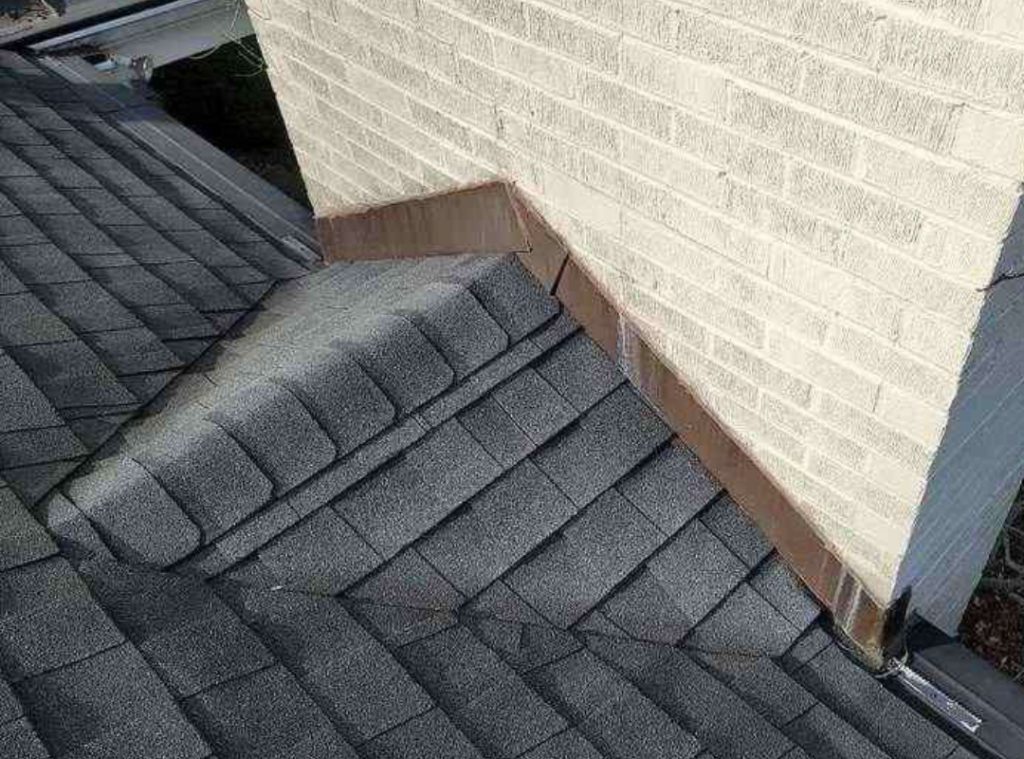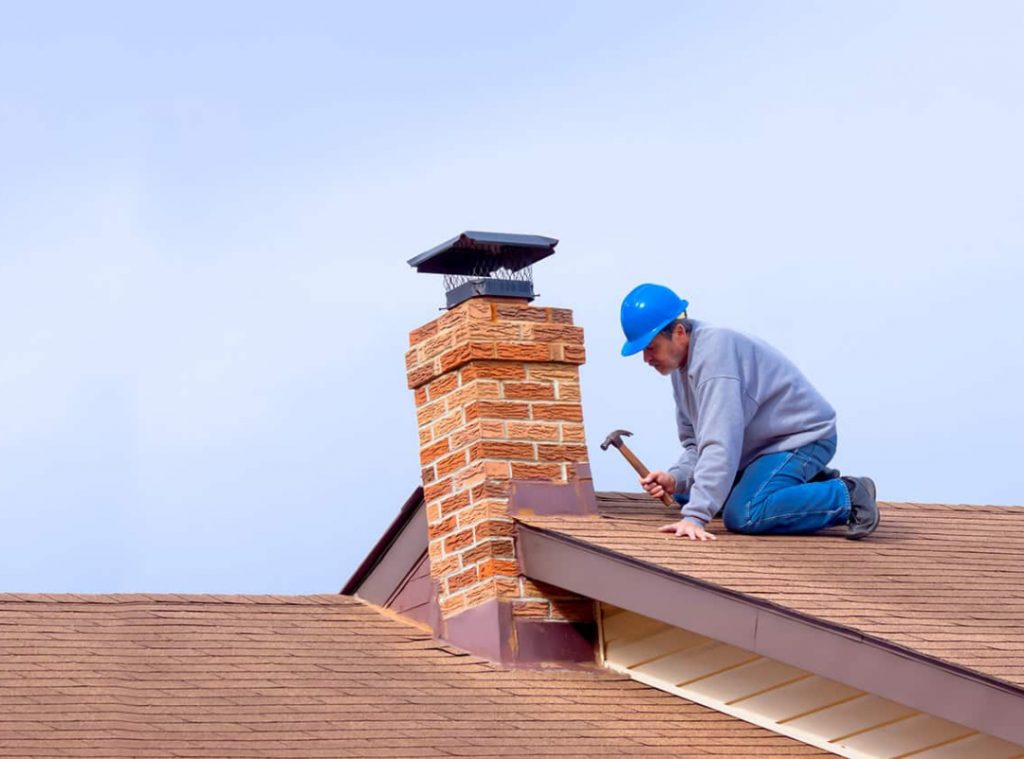Published on: June 10, 2022

If you have a chimney, you’ll need a roof cricket to protect your home from vulnerabilities. This aspect of your roof requires some added know-how to install because your roofing contractor will need to complete the flashing thoroughly to protect your chimney using the roof cricket or a roof saddle.
Although your area may or may not have a building code requirement for a roof cricket when a chimney is present, it’s a good idea to have your roofers install one.
But what is a roof cricket and why will your roofing team recommend using one? Get the full scoop on this important tactic for protecting your home.

This aspect of roofing helps divert water away from your chimney and downward away from your roof using a sloped backing made from wood with metal flashing or asphalt shingles on top.
Talented roofing contractors incorporate the cricket and chimney flashing system. Some other names for a roof cricket include a chimney saddle or chimney diverter.
If your roof lacked a roof cricket, water would hit the back wall of your chimney after sliding down your roof lines. And while the water would go down the sides, it wouldn’t move fast enough, which would mean water pooling behind your chimney. Over time, that will wear away the masonry of your chimney and could cause some serious damage that would call for costly repairs.
Historic homes are especially challenging to repair because the chimney’s materials might no longer be available. You could find yourself ripping out the entire chimney infrastructure to make it all match or having some mismatched stones if you experience water damage.
The roof cricket ensures that water does not pool near your chimney. It pushes rainwater to either side of the chimney and downward toward your gutters, which is where you want the water to go.
When building a cricket, you want to ensure that the slope is high enough that heavy rainwater would never reach its peak. Roofers often build the cricket with a higher pitch than the roof plane to ensure no water can pool.
When you think about the various names for roofing materials and tactics, cricket probably stands out as a bit strange or unique. The origin of the roofing term is somewhat of a mystery.
The best theory is that it comes from the fact that roofers used this part of the roof as a low stool when taking a break during a busy workday. But that theory is disputed because roofers don’t sit down on roofing features like that.
If you review your area’s building codes, you might not see anything about needing a cricket when you have a chimney. What you might see in the requirements is the need for a roof saddle when your chimney exceeds 30 inches in width.
When measuring your chimney to see if it meets the requirements for using a cricket or saddle, make sure you’re measuring the side that runs parallel to the roof’s ridge because that’s the side that is most vulnerable to pooling water.
Some chimneys intersect with the roof’s ridge. In this case, you won’t need a cricket because you are not at risk of water pooling around your chimney.
As you review the building code requirements though, take a look at how high the cricket must extend up the chimney. Requirements for higher crickets mean a steeper pitch. Generally, the steeper the pitch of your roof, the steeper your cricket pitch.
Ultimately, your cricket’s slope will match that of your roof. Normally, building codes won’t state the slope requirements but instead the height requirements for the cricket.
If you’re unsure of your requirements, you can reference the 2015 International Residential Code to review the guidelines and requirements for installing a cricket that will properly protect your home or building.

Roofing is not a recommended DIY project, and that includes building a cricket. One small mistake and you could get seriously injured during the project or leave your home vulnerable to severe damage and costly repairs.
Roofs play a crucial role in moving water away from your home and protecting its foundation. One wrong move and you could end up with severe damage to your home.
The cost of installing a roof cricket will vary based on the size of your chimney. On average, cricket installation costs about $400 for parts and labor. But if you need chimney repair due to the lack of a cricket, the cost of this service will be about double.
That’s simply an estimate though and the final cost will be impacted by the time of year and demand for roofing work.
Although you should not attempt building the cricket yourself, here’s a look at the steps you can expect your roofing contractor to make in building a chimney cricket.
Measure the chimney, roof and slope of the roof with incredible precision. This will impact the slope and pitch of the cricket, which is why this step is so important. Understanding how to calculate the slope of the cricket based on your roof’s slope is a crucial aspect of a high-quality cricket install.
Remove shingles from around the area to prep it for building the cricket. You do not want shingles underneath, impacting the seal and quality of the cricket install.
Now your roofing contractor will begin building the frame based on measurements and requirements. This includes putting wood sheathing over the cricket frame.
Because you’re redirecting water using the cricket, you’ll need a waterproof barrier to protect your home from water damage.
Now that you have the cricket built, you’ll need to use new roofing materials to cover the cricket and install a metal step and counter flashing.
A high-quality roof installation is essential for protecting your home from water damage. Water penetration and pooling can deteriorate your home’s brickwork quickly and lead to serious leaks.
Diverting water away from your house is the whole goal of roofing, which is why you don’t want to overlook crucial aspects of roofing, such as a cricket or saddle.
Hiring the best roofing contractors is so important to protecting your home long-term. Learn more about how to prepare your home for roofing installation and what types of roofs work best for Washington state homes.
If your home doesn’t have a chimney cricket or has an inadequate cricket, you should look to get roofing repairs as soon as possible to avoid serious issues.
2FL Windows, Siding and Roofing is the team of experts you want working on your roof. We’ll ensure your home meets building code requirements while also providing top-notch protection for your home or commercial building. Schedule your free estimate now to learn more about our skilled team.
Further Reading:
Comments are closed.

Read the latest articles about roofing.







[…] What Is a Roof Cricket and Why Do You Need One? […]
[…] What Is a Roof Cricket and Why Do You Need One? […]